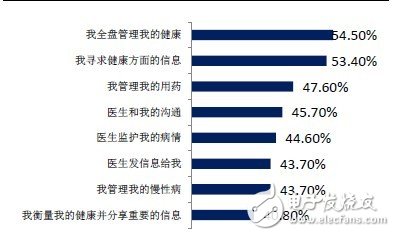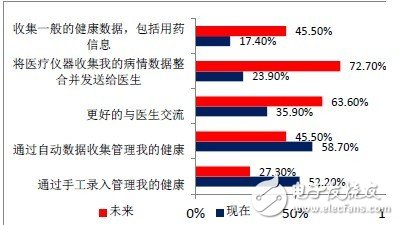GoogleGlass and iWatch conveyed the idea that wearable devices will become the future trend to the public. Among the many wearable devices, functions include improving people's social life, entertainment, fitness, navigation and other aspects. The most revolutionary function.
Health management is to turn passive disease treatment into active management of health, so as to save medical expenses and maintain health. If we say that GoogleGlass brings people an optional consumption that improves the quality of life, everyone is under the threat of disease in modern society. As people pay more attention to their own health, wearable medical devices have become more extensive. Based on the demand, health and medical equipment will become a necessary consumer product. The overall level of medical and health expenditure in China is relatively low. With the improvement of living standards, the proportion of medical and health expenditure has risen steadily.
According to ABI's survey data, about 30 million wireless wearable health sensors were used in the medical electronics field in 2012. This number has increased by 37% compared with 2011. ABI predicts that applications for remote patient monitoring and online professional healthcare will account for 20% of the overall wearable wireless device market in 2017. According to BCCResearch's forecast, the mobile medical market will grow from US $ 9.8 billion in 2010 to US $ 23 billion in 2015, with a compound growth rate of 18.6%.
According to statistics, the prevalence of elderly people over 65 years old is about 3 to 7 times that of young adults aged 15-45. China's growing aging trend is the foundation of health care growth. The trend of empty nesting and the increase of elderly people living alone, the demand for wearable smart medical devices that can realize remote real-time monitoring will continue to increase.
The State Council General Office issued in 2011 the "Social Pension Service System Construction Plan (2011-2015)" pointed out that China's population aging is accelerating, the elderly population base is large, rapid growth and increasingly showing an aging, empty nesting trend. It is expected that China will enter the accelerated aging stage from 2020 to 2050. Due to the fertility peak in the 1960s and 1970s, this stage will increase by 6.2 million people every year. By 2050, the total aging population will exceed 400 million, and the aging level will reach 30%.

Figure 1: The growth of the elderly and the proportion of the elderly in the total population
According to the survey results of the National Aging Office, at present, the proportion of urban elderly empty nest families (including living alone) in China has reached 49.7%, and the proportion of elderly empty nest families (including living alone) in large and medium-sized cities is as high as 56.1%. The increase in the number of elderly people living alone and the increase in labor costs are an important factor that will increase the demand for wearable smart medical devices that can realize remote real-time monitoring.
According to the data published in the "China Chronic Disease Prevention Work Plan 2012-2015" released by the Ministry of Health in 2012, the number of chronic disease cases has risen rapidly, with 260 million patients diagnosed. The chronic diseases that affect the health of the people mainly include cardiovascular and cerebrovascular diseases and malignant tumors. , Diabetes, chronic respiratory diseases, etc., the deaths caused by chronic diseases have accounted for 85% of the total deaths in China, and the disease burden has accounted for 70% of the total disease burden. At present, China has entered a period of high burden of chronic diseases, with the characteristics of "large number of patients, high medical cost, long time of illness, and large service demand".
The "2012 White Paper on the Health of Chinese Urban Residents" found that people between 35 and 65 years of age are becoming an army of chronic diseases. Among them, overweight and obesity, dyslipidemia, fatty liver, and hypertension are on the rise, and the age of onset is getting younger. Before the disease occurs, there is usually "physiological abnormality". By measuring the sub-health indicators, chronic diseases can be discovered early, which is conducive to treatment.
Figure 2: Composition of major male health problems

Figure 3: The composition of female major health problems

Wearable medicine allows patients (users) to manage their own diseases and get timely help. Therefore, in any chronic disease, millions of active and focused users are entirely possible, and the clinical data of a large number of users has huge commercial value and social value.
Wearable smart medical treatment can assist patients with scientifically designed personalized health management, correct functional pathological conditions by checking indicators, and interrupt the pathological change process. Reasonable chronic disease management can avoid emergency and hospitalization and reduce the number of medical treatments. The resulting cost and labor cost savings. Global clinical research on the effectiveness of mobile medical services has shown that remote monitoring after discharge can reduce the patient's total medical expenses by 42%, extend the time between doctor visits by 71%, and reduce hospitalization time by 35%.
Figure 4: Global clinical research on the effects of mobile medical services

Patients expect mobile medical devices to help them manage their overall health and hope to obtain medication information. According to a survey by the Economics Think Tank, the mobile medical project with the highest willingness to pay is to collect medical data and send it to the doctor to better communicate with the doctor.
Figure 5: What patients expect from mobile medical care

Figure 6: Consumer payment survey for mobile healthcare

Among the US PE fund investment projects, medical-related investments accounted for 37.4%, exceeding Internet-related investments by 10 percentage points. In the sub-sectors of medical-related investment, medical equipment investment accounts for more than half.
LED Point Light emit homogeneous beams in the ultraviolet, visible and infrared spectral. Power from 1watt to 11watt could have nice brightness. Application for outdoor situation, such as bridge, building, plaza, etc. Single color and RGB color work with control system make the illumination amazing.
Bright Point Light,Led Pixel Point Light,Led Point Light,Led Point Light Source
ZHONGSHAN G-LIGHTS LIGHTING CO., LTD. , https://www.glightsled.com